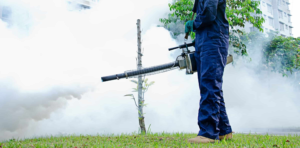Killian Pest Control aims to reduce pest numbers to an acceptable level with minimal harm to other organisms. Methods include prevention, suppression, and eradication.
Preventive measures may include cultural practices such as good sanitation, removing debris and infested plant material, growing competitive plants, or using barriers. Mechanical and physical controls include traps, screens, barriers, cultivation, soil solarization, and heat treatments.

If you want to avoid pest infestation problems, then you must keep your home clean. This means more than just sweeping or wiping down surfaces; it is also necessary to vacuum and clean your house regularly and remove clutter and debris. In addition, you should store food in airtight containers and periodically wipe down cupboards and storage spaces to eliminate crumbs.
Rodents, cockroaches, ants, and other pests often invade homes because they are looking for warm shelter or food. They carry disease-causing germs and may cause serious health problems for your family if they enter your home. Therefore, pest prevention is one of the best ways to protect yourself and your family.
Unfortunately, even the cleanest homes can experience pest problems if the right conditions are present. Many pests are attracted to dirty, unkempt homes and can easily crawl into your home through tiny cracks or openings. Some pests are also attracted to cluttered areas and infrequently used closets, basements, attics, or garages, where they can hide until you discover them.
A common sign of a pest problem is droppings, gnaw marks, damaged food packaging, or a nest. These can indicate that there is a pest infestation in your home. If you find any of these signs in your home, you should take action immediately to prevent the pests from spreading further and causing more damage to your property.
Keeping your home clean can help eliminate pests like cockroaches, ants, rodents, and bees. You can use household items such as soapy water or diatomaceous earth to eliminate these pests. These substances are effective in eliminating pests because they dehydrate them.
You can also keep plants around the house that naturally repel pests. Some plants, such as marigolds, release a pleasant fragrance that will make your home smell nice and repel bugs. You can also use essential oils such as peppermint or eucalyptus to keep pests away from your house. Add 1/4 tsp of this essential oil to a cup of water and then mist it around your home.
Pests can be annoying and difficult to control, especially during certain times of the year. In addition, many pests carry diseases and can destroy property, food, and clothing. Properly sealing your home and business can prevent pests from entering, making them less of a nuisance and decreasing the damage they cause. Pest exclusion is essential to integrated pest management (IPM) because it can prevent the spread of harmful insects and rodents.
The first step in preventing pests is to look around your home or business for possible entry points. The most obvious entrances are through doors and windows, but you should also examine the outside of your property for cracks or openings. Seal holes with caulking or urethane expandable foam if you see any holes. Then, consider using door sweeps to close gaps under doors and to keep bugs and debris out, air curtains to stop flying pests, or copper mesh to deter mice because they cannot chew through it.
Other potential entry points are holes drilled for various utilities, such as phone and cable lines or plumbing and HVAC lines over the years. These can be sealed with mortar, caulk, steel wool, or urethane expanding foam. You should also look for vents on the roof, basement, and crawl spaces and cover them with metal wire mesh to prevent rodents from accessing them.
If you have searched for and sealed any possible entry points but still find pests, then traps help track down where they are entering. If you continue having a problem, contact your pest professional for more suggestions and treatments to eliminate them.
Rodents, ants, and other pests can destroy food in the pantry, ruin clothes and fabrics in closets, and cause structural damage to structures, electrical cords, and pipes. They can also transport bacteria and pathogens, which can contaminate the food you eat. Taking the time to inspect your property regularly and practice proper food storage, garbage disposal, and cleaning techniques will go a long way in keeping pests away from your home or business. Still, you should partner with a professional pest control company for the most effective protection.
Food preparation facilities must follow certain hygiene practices to avoid pest infestations, which can cause various problems, including contamination, loss of production, and even health risks for workers. Keeping food items secure in airtight containers, wiping down counters, and sweeping surfaces regularly are just some ways food businesses can keep pests away from their products.
While sanitation and exclusion are the most important steps for a food business to take to prevent pest control problems, it is also important that all employees understand how to correctly identify pests and what the signs of a pest problem may be. This helps to eliminate the use of pesticides where they are not needed and prevents staff from contaminating foods to treat a pest problem.
A pest is any living organism that poses a risk to humans. This includes bacteria, viruses, fungi, mites and rodents. Pests can transmit harmful parasites to food and damage products, machinery, or supplies in a food establishment. In addition, some pests carry dangerous diseases that can be transferred to customers and clients.
As do the weather and other environmental factors; all pests have natural predators and enemies that help control their numbers. Pests can also be governed by different methods, such as physical controls (traps, screens, barriers, fences, and nets), chemical controls (selective pesticides and repellents), and biological controls (fungicides, herbicides, nematodes, and pheromones).
Food companies should ensure that their pest management programs comply with the British Retail Consortium’s (BRC) Standards, which include specific requirements for quality management, Hazard Analysis, and Critical Control Points (HACCP). Another important requirement is to have a plan to identify and control the causes of any pest problems.
A detailed inspection should check for contaminated food, harborage areas, entry points, and other known risk factors that can lead to pest infestations. This should be done weekly, focusing on where food is prepared and stored. A pest control specialist can 2advise on the best inspection techniques to reduce the risk of pest infestations in a food production environment.
Pests like roaches, termites, rats, ants, bed bugs, and fleas can cause health problems such as contaminated food, asthma, and allergic reactions. They can also taint buildings and damage property. However, pests can be kept at bay by practicing good sanitation habits in our homes and workplaces. These include storing and preparing food properly, cleaning and disinfecting countertops regularly, sweeping up crumbs and spills right away, securing garbage bins tightly, removing pet food from the outdoors overnight, and removing discarded boxes or other unused materials.
Clutter can provide hiding places for pests and makes it hard to sweep or vacuum them away. Therefore, it is important to declutter our living spaces and eliminate unused items such as stacks of paper, old toys, discarded shoes and clothing, and empty containers. It is also advisable to clean and seal crevices around cabinets and baseboards. These can be filled with steel wool or caulk.
Regularly scouting our properties for pests is also an effective pest control strategy. It allows us to identify and respond quickly to infestations before they become a serious problem. The scouting process also helps us understand what conditions attract particular pests and how to prevent them.
The use of physical controls to keep pests at bay is known as Integrated Pest Management (IPM). This involves blocking off entry points, sealing cracks, and destroying nests and other breeding grounds. It can also include removing rubbish and composting organic matter properly.
Chemical pesticides are often used to control pests but must be carefully selected, applied, and always used following the product label. They should never be sprayed in areas where children or pets might come into contact with them. They should be stored safely out of reach and away from water sources, such as the kitchen sink.
In addition, pest control methods should consider the pest’s life cycle and migratory patterns. This is because pests can be controlled more effectively in the early egg, larval, nymph, or pupal stages.



